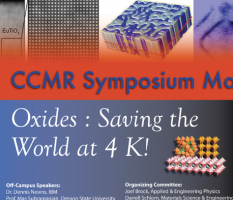Home⁄ About⁄ News⁄ 2013 CCMR Symposium, Complex Oxides
2013 CCMR Symposium, Complex Oxides

On May 29, the CCMR held its 2013 symposium. It focused on Complex Oxides. The symposium is a day-long event, which gathered 135 off-campus guests and Cornell faculty and students. At the end of the day, a poster session gives an opportunity to students to meet the industry attendees. The 2013 Symposium off-campus attendees selected for best poster: “Co3O4 Nanoparticle Assemblies for Binder-Free and Carbon-Free Nanoparticle Batteries” by Don-Hyung Ha, Mohammad Islam, and Prof. Richard Robinson.
The Organizing Committee, Joel Brock (Applied & Engineering Physics) Darrell Schlom (Materials Science & Engineering) and Kyle Shen (Physics) invited Prof Ramesh, at the time Professor of Materials Science and Physics at Berkeley, to give the Sproull lecture. Prof. Ramesh left Berkeley in June to become Deputy Director for Science and Technology of the Oak Ridge National Laboratory. Prof. Ramesh spent the last two years in Washington DC as Director of the SunShot Initiative and worked directly for the Secretary of Energy, Dr. Steven Chu. Prof. Ramesh set the agenda and the funding priorities of SunShot and led it to drive not only research, but manufacturing, and market solutions in photovoltaics and in concentrating solar power.
Prof. Ramesh and the other speakers emphasized the technological challenges of integrating multiferroic materials into commercial products and of developing high quality multiferroics with specific functionalities, and functioning at Room T. But he and others emphasized also the role that serendipity plays in scientific discovery. This was illustrated by the presentation of Prof. Mas Subramanian from Oregon State University. Prof. Subramanian was exploring the electronic properties of manganese oxide. By heating it to 2000 degrees Fahrenheit, what popped out of the oven, instead of a new high-efficiency conductor, was a brilliant blue compound, an extremely stable pigment, environmentally friendly and relatively inexpensive. With minor tweaking, the chemistry of the substance was altered to produce other colors: orange, aquamarine, green, brown, yellow, and turquoise. These pigments are now commercialized by a worldwide leader in pigment manufacturing.
Many thanks to the Cornell organizing committee, the CCMR staff and the attendees!
We hope to see you next year!
